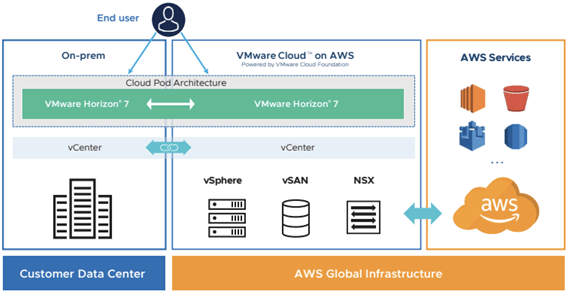Increase your employee productivity by Implementing VDI
What is VDI?
The infrastructure which provides a pool of virtual desktops to the end-users is known as VDI or Virtual Desktop Infrastructure. According to the type of workloads, administrators can assign the type of virtual desktops (Dedicated/floating/shared) to the end-users. If the requirement is only to allow the specific application and not the full desktop access, then the same can be achieved by Application virtualizations.
| S.No | Physical Desktops/Workstations | Virtual Desktop |
| 1 | No centralized management | Centralized management |
| 2 | No efficient utilization of underlying hardware resources | Efficient utilization of underlying hardware resources |
| 3 | Need 3rd party NMS tools to monitor all the physical desktops | Inbuilt centralized monitoring |
| 4 | Need to perform repetitive tasks for Installing/uninstalling applications in all the physical desktops. | No repetitive tasks just deploy applications once in Golden/master image. The same can be used by the multiple VDI instances |
| 5 | High OPEX – High power consumption, Need multiple support engineers, high maintenance cost | Reduces the OPEX- Since VDI run on the centralized hardware it consumes very little power than multiple physical desktops, just one administrator can manage the complete infrastructure |
| 6 | To upgrade/ change the hardware downtime is required | VDI will be running on top of the high availability cluster. Administrators can scale up / scale out the hardware without downtime |
Why should every organization focus on VDI?
For every organization, their employee’s productivity is very important. Following are the key benefits by providing the virtual desktops access to the end-users which intern increases the employee productivity
- Work from anywhere from any device
- Easy accessibility from any browser/ thick client
- End-users can access their virtual desktops/application through SSO credentials. Also, an option to add Multi-factor authentication
- Granular security & device compliance by applying MDM policies
- Provisioning and deprovision of virtual desktops/ application in few minutes
- VDI is suitable for any kind of end-user workload. we can categorize in three type
- Heavy workloads -Catia, Auto CAD, Maya, Photoshop, etc.,
- Medium workloads – Visual studio, Adobe dream viewer, etc.,
- Light workloads – MS word, excel, PowerPoint, Outlook, Chrome, teams, etc.,
- Better visibility and control of the complete VDI infrastructure
- No complexities any operations can be performed in just a few clicks
- Reduces the OPEX and Better ROI.
Who are the market leaders in VDI?
As you all know nowadays for any technology there are multiple competitors. Following are the market leader in VDI
VMware Horizon – On-premise & Cloud offering
Citrix Xen Desktop – On-premise & Cloud offering
Azure WVD – On-premise & Cloud offering
Amazon workspaces – Only Cloud Offering
Nutanix Xi Frame – On-premise & Cloud offering
Which one to choose VDI On-Premise or Cloud?
If you are a startup or small organization with an employee count of less than 50 and the end-user workloads are lightly weighted such as MS word, excel, PowerPoint, outlook, HRMS, CRM, etc., you can opt for VDI on a cloud which also called as Desktop as a Service.

If your organization has more than 50 employees and the end-user workloads are mixed type (Heavy, Medium, Light) then you can start with 3 Node On-premise VDI Solution and scale-out by adding the nodes whenever you need.
Are you looking for a VDI solution?
Here Are The 5 Things To Do To Implement VDI
1. Get consolidated resource requirements such as Core, RAM, Storage, and end-user count
2. Choose the base hardware platform. The HCI (Hyper Converged Infrastructure) is the best-suited platform for VDI. The HCI market leaders are Nutanix, Vmware vSAN, DELL EMC Vxrail, Cisco Hyperflex & HPE Simplivity
3. Choose the VDI platform. The VDI market leaders are VMware Horizon, Citrix Xen Desktop, Azure WVD & Nutanix Xi Frame
4. Deploy and Configure the VDI platform
5. Provision the Virtual Desktops/ Applications to the end-users
We have Designed & Implemented the VDI solution successfully for the end-user count starting from 100 to 10,000. The customers are from different verticals such as Manufacturing, Pharma, IT, Automobile & Defense.
If you need any assistance in the VDI solution design/Proof of Concept/ Implementation, please reach us at [email protected] or call us on +919773973971.
Author
Leela Krishnan R
Data Center Consulting Engineer
